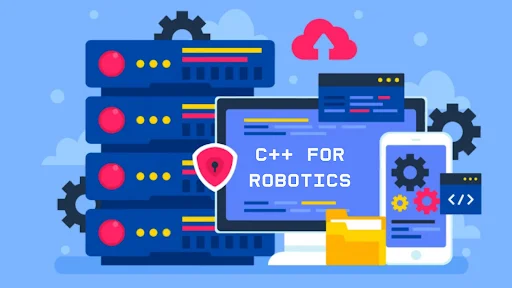Introduction:
Robotics in business thrives when it is driven by powerful technology, such as C++, which stands out as the backbone of high-performance robotic systems. Mostly, it has been seen that without it, companies often struggle with delayed response times, weak hardware control, and system inefficiencies that limit product success.
These issues can stall innovation and impact reliability where precision is non-negotiable. Here, C++ steps and addresses these challenges by offering low-level hardware access, real-time processing, and exceptional speed. It empowers businesses to build robotics that are not only faster but also more stable and scalable. Read the blog to know more about how C++ for robotics can elevate your robotics strategy.
What Are the Strategic Roles of C++ for Robotics in Business?
Underestimating the role of C++ often leads to performance limitations in robotics-driven businesses. Its strategic use ensures systems are not only responsive but also aligned with industry-specific demands. From precision to scalability, C++ supports robotics that delivers consistent business value. Below are some of the strategic roles that firms are looking to implement in their workflow:
1. Drive Performance in Real-Time Operations
C++ is essential in making robotic systems react in the moment to real-world events; it is crucial in industries such as manufacturing, logistics, and healthcare. Its capacity to process high-speed data and commands with little lag ensures smooth, unfettered workflows. For companies, this translates into decreased downtime, quicker task execution, and smooth performance even during intense operational stress.
2. Facilitates Deep Hardware-Level Integration
C++ allows companies to directly interface robotics systems with hardware elements, improving customization and accuracy. The degree of control is essential when robotics is customized for specific processes or industry-specific machinery. This way, companies enjoy more dependable performance and smooth interaction between physical equipment and digital smartness.
3. Supports Scalable Robotics Product Development
From initial prototypes through high-scale deployment, C++ offers a stable base that adapts to your robotics strategy. Its support for popular frameworks such as ROS makes it perfect for long-term development without starting the entire system over. Companies can scale up their robotics capabilities effectively while safeguarding their development investment.
4. Enhance Robotics Reliability and Stability
C++ for robotics enables systems to be robust, stress-tolerant, and reliable in performance. Its structural strength minimizes the likelihood of system crashes, erratic errors, or failed runs, resulting in downtime for services. For companies, this means more reliance on automation and fewer operational delays.
5. Facilitates Industry-Specific Innovation
Regardless of precision agriculture, warehouse automation, or intelligent healthcare devices, C++ enables robotics to be tailored to business-specific requirements. Its flexibility accommodates intricate logic and performance demands specific to every business model. This gives companies the ability to develop differentiated products and services that closely match market requirements.
Top 5 C++ Models Powering Robotics in Modern Business Operations
Robotics systems require more than just automation; they demand precision, responsiveness, and scalable architecture. Below are some of the models of C++ for robotics that are built to meet these expectations and deliver reliable performance across high-demand business operations. For this, many firms hire C++ developer to gain access to make tailored solutions that align with evolving industry needs. This approach ensures robotics deployments remain efficient, adaptable, and future-ready.
1. Autonomous Navigation Systems
C++ drives robotic navigation algorithms used in autonomous cars, warehouse robots, and delivery networks that need immediate decision-making. These algorithms receive environmental inputs and calculate optimal paths in real time, paving the way for smooth travel with little latency. Companies utilizing these systems gain increased logistical efficiency and decreased man-in-the-loop intervention. This model is well scalable to fleet size and complexity.
2. Industrial Manipulator Control Models
Robotics arms employed for assembly, welding, or packaging tend to be based on C++-centric control models to provide precise motion. Such models enable robots to carry out repetitive functions with micron-scale accuracy and reliability. Companies achieve higher throughput, enhanced product quality, and lower operational expenses. C++ guarantees that these systems are stable, even with constant high-volume usage.
3. Real-Time Feedback and Sensory Integration Models
C++ allows robotics to process real-time sensor data from cameras, sensors, and actuators to make decisions in real-time. These models are essential in robotics deployed for inspection, surgery, or quality control. They make robotic systems respond immediately to external stimuli without delay, minimizing risk and maximizing safety. This means smarter robotics for businesses that adapt and execute with high confidence.
4. Robotic Process Automation (RPA) with Embedded Intelligence
C++ is applied in embedded robotics, where programs must drive physical hardware autonomously, such as vending systems, hospital robots, or farming equipment. The models integrate mechanical motion with logic decisions to mechanize low-level operations. C++ allows for deep integration of hardware with limited resource use. Companies enjoy small, affordable solutions that provide repeatable results.
5. Modular Robotics Platforms with C++ Core
C++ is the foundation for orchestrating individual robotic modules in reconfigurable or scalable robotics platforms. Such models enable companies to deploy flexible systems that can change form or function depending on requirements, perfect for field robotics or manufacturing. C++ facilitates quick inter-module communication and robust orchestration. This model accommodates long-term flexibility without compromising speed or stability.
What Businesses Can Achieve Using C++ Solutions for Robotics
With the adoption of C++-based robotics solutions, businesses gain performance-centric automation that is scalable and robust. For product innovation, smart operations, or leadership in the market, C++ enables robotics to deliver real-time precision and long-term stability. All these features enable businesses to lead in competitive, tech-driven environments.
It assists the business to
– Accelerate time-to-market for robotics-enabled products
– Minimizes operational breakdowns and maintenance expenses
– Offers a precision-based automation with less human oversight
– Delivers a competitive advantage through customized and scalable robotics solutions
Real-World Use Cases of C++ For Robotics for Business Impact
1. Tesla – Autonomous Car Control Systems
Tesla uses C++ to drive its real-time decision-making in Autopilot and Full Self-Driving. The two technologies require super-fast processing and direct hardware access, both of which are C++ strengths. Tesla can thus support high safety, accuracy, and responsiveness in dynamic traffic situations.
Before you head out, don’t forget to check out some of our other great reads!
2. ABB – Industrial Robotics in Manufacturing
ABB, a world leader in industrial automation, employs C++ in its robotic arms and manufacturing systems. The robots need precise timing and dependability during welding, assembly, and packaging. C++ helps ABB provide stable, high-performance automation to industries.
3. Intuitive Surgical – da Vinci Surgical Systems
Intuitive Surgical’s da Vinci robotic surgery platform employs C++ to manage motion, haptics, and vision systems. The programming language is designed for real-time responsiveness in minimally invasive surgical procedures. This maximizes safety, accuracy, and trust in robotic surgery conducted by hospitals globally.
4. Amazon Robotics – Warehouse Automation
Amazon Robotics employs C++ across its autonomous mobile robot fleet, which handles inventory movement in warehouses. The robots depend on C++ for fast environmental processing and task execution at scale. This enables Amazon to enhance fulfillment speed, minimize labor dependence, and ensure operational continuity.
Conclusion:
C++ continues to define the application of robotics across sectors through the provision of precision, speed, and long-term stability. Its capacity to execute real-time operations, in addition to not losing control at the hardware level, makes it a strategic tool for companies investing in robotics.
Whether scaling innovation or optimizing operations, C++ for robotics provides technical depth to facilitate those aims. To deploy C++, the best option is to choose a C++ development company, as it helps your firm accelerate its technical workflow smoothly by providing solid, scalable solutions. C++ for robotics is not merely a tool with the right strategy; it’s a future-proofing enabler for smart automation.
Looking for more insights? Dive into our latest posts before you leave!






